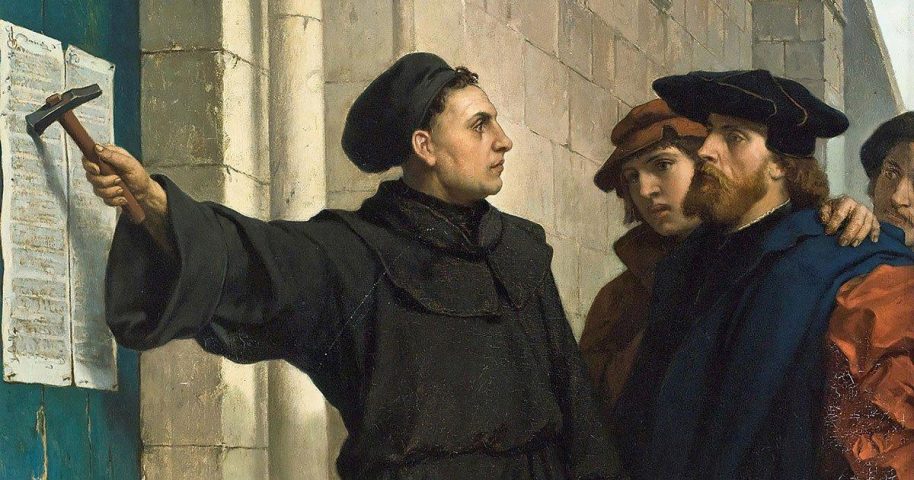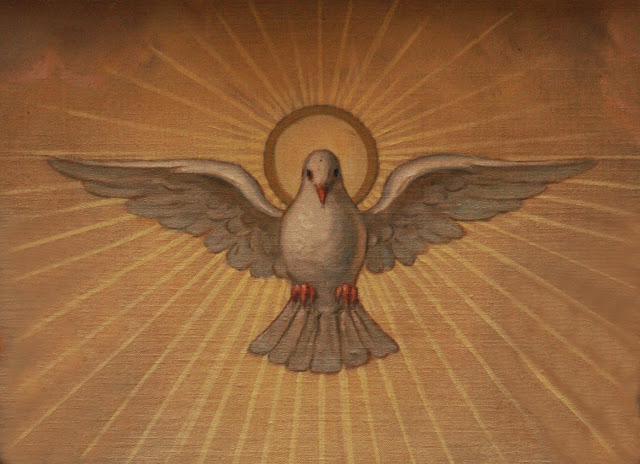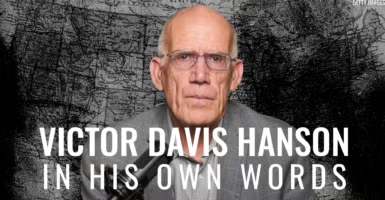By Gene Thomas Gomulka, Complicit Clergy, November 9, 2024
Gene Thomas Gomulka is a sexual abuse victims’ advocate, investigative reporter, and screenwriter. A former Navy (O6) Captain/Chaplain, seminary instructor, and diocesan respect life director, Gomulka was ordained a priest for the Altoona-Johnstown diocese and later made a Prelate of Honor (Monsignor) by St. John Paul II. Email him at msgr.investigations@gmail.com.
The recent U.S. presidential election demonstrated how pollsters often get it wrong. Will this also happen in the case of the next papal conclave? Just as many political analysts like to compare the outcomes of different elections, so too might we compare similarities in the current college of cardinals to papabile of another time. This will require that we set the dials on our time machine and travel back to Wittenberg, Germany on October 31, 1517 when Martin Luther nailed his 95 theses to the famed “Castle Church Door.”
During the outbreak of the Protestant Reformation (1517-1648), Martin Luther was excommunicated after he refused to renounce his writings critical of practices like the selling of indulgences to obtain the forgiveness of one’s sins. While Catholic Church historians are prone to report how Luther in 1523 married Katharina von Bora, a former nun, they often fail to note how Pope Leo X (1513-1521) and Pope Julius III (1550-1555) were both sexually active homosexuals during this turbulent period. For example, Leo X who excommunicated Luther in 1521 was said to have been elected because the conclavists were looking for a candidate who would serve a brief pontificate. The cardinals knew Giovanni di Lorenzo de’ Medici was a homosexual and they elected him, Pope Leo X, believing he would die soon as a result of an anal fistula caused by “unsafe sex.” It was also during the Reformation in 1550 that the conclavists elected Giovanni Maria Ciocchi del Monte who took the name, Julius III. A sexually active homosexual like Leo X, Julius III was reported to have “shared [his] bedroom and bed” with 15-year-old Innocenzo Ciocchi Del Monte whom he made a cardinal at the age of 17.
Luther is widely anathemized as a controversial cleric who challenged Catholic doctrine, but he also sought reform of clerical corruption and abuses that were scandalizing the Faithful. While some Catholic apologists like to paint Luther as a heretic, there are other Catholic historians who would argue that it was the scandalous homosexual popes, Leo X and Julius III, who would “split the Western Church in a seismic schism not experienced since the rending asunder of Rome from the Eastern churches in 1054 AD.” After witnessing all the damage Leo X and Julius III had done, the cardinal electors reversed the downward spiral of the Catholic Church following the death of Julius III by immediately electing Michele Ghislieri who took the name Pius V. Feeling called to uphold the teachings of the Catholic Church that viewed homosexual behavior as immoral and sinful, Pius V issued a bull in 1568 against homosexual clergy (Horrendum Illud scelus) calling for homosexual priests to be deprived of their dignity and be delivered to the secular authority to be put to death. After Pius V was canonized a saint in 1712, Cardinal John Henry Newman would later write, “St. Pius V was stern and severe … Yet such energy and vigour as his were necessary for the times. He was a soldier of Christ in a time of insurrection and rebellion, when in a spiritual sense, martial law was proclaimed.”
Many Catholics would find what happened in the sixteenth century under Leo X and Julius III to be recurring today under Pope Francis. Just as Leo X excommunicated Luther, so too did Francis excommunicate Archbishop Carlo Maria Viganò whom he accused of schism after Viganò accused him not only of covering up for sexual predators like ex-Cardinal Theodore McCarrick, but also of engaging in the same predatory behavior as McCarrick when he was Master of Novices of the Society of Jesus in Argentina. Before his excommunication, Viganò also accused Francis of “heresy and schism” over his promotion of COVID-19 vaccines and his overseeing of the secret Vatican-Beijing agreement granting the Chinese Communist Party (CCP) a role in the appointment of bishops.
While twentieth-century popes like John XXIII and Paul VI were thought to be homosexual, neither of them was ever accused of preying on seminarians as Francis has been accused of doing. The fact that Francis dismissed Viganò’s accusation of covering up for McCarrick with the publication of the whitewashed McCarrick Report, it came as no surprise that he refused to deny Viganò’s allegations about his sexual involvement with novices. Francis’ appointment of his homosexually promiscuous friend, Monsignor Battista Ricca, to be in charge of his papal residence; his failure to laicize over 150 bishops credibly accused of abusing minors and vulnerable adults; as well as his alleged lifting of the excommunication of Father Marko Rupnik who is accused of raping some 25 nuns, lead some to believe that Francis cannot discipline and punish clerics for the same behavior he himself is guilty of doing.
Viganò is not the only bishop to be reprised against by Francis for speaking out against sex abuse and cover-ups by members of the hierarchy. Former Tyler Bishop Joseph Strickland was removed from office by Francis after Strickland accused him of “undermining the deposit of faith.” Although removed from office in November 2023, Strickland’s fate was actually sealed when he had the audacity of addressing his fellow bishops at the November 2018 meeting of the United States Conference of Catholic Bishops (USCCB), urging them to support the disciplining of those who engage in or cover up clerical sexual predation and homosexual misconduct. Unfortunately, Strickland failed to realize how many bishops like Archbishop George Lucas and priests like Monsignor Jeffrey Burrill present at the meeting were themselves guilty of the very behavior Strickland felt needed to be addressed.
Unlike in the past when sexually active homosexual popes like Leo X and Julius III never tried to change the Church’s teaching on homosexuality, and heterosexual popes who had affairs with women never tried to change the teaching of Christ and the Church on adultery, today dedicated and faithful prelates like Viganò and Strickland are being discarded by Francis for questioning attempts to change doctrinal and moral teachings with the promulgation of heretical documents like Fiducia supplicans which authorizes the blessing of same-sex couples.
Compromised by his own sexual own orientation, Francis, along with the majority of bishops and priests from the Americas and Europe who are homosexuals, are mute in defending the Church’s teaching that homosexual behavior is as immoral as adultery. Clearly, when asked to pass judgment on the woman caught in the act of adultery, Jesus did not respond, “Who am I to judge?” He did not dismiss the Jewish law prohibiting adultery as “anthropologically dated.” What he did say was, “Go, and sin no more.” Rather than preaching that “the Church cannot bless sin,” many homosexual Church leaders are clearly attempting to change the Church’s doctrinal teachings and promote homosexual unions as natural and moral as God’s life-giving plan for marriage and family.
Aware of this development, Bishop Joseph Strickland recently suggested that Church leaders who wish to significantly alter Catholic teachings should leave the Catholic Church and establish a separate denomination or affiliate with a faith group that accepts homosexual behavior, abortion, and other practices as morally acceptable. The only problem with this suggestion is that Francis and other closeted heterodox Church leaders do not want to give up their “comfortable digs” that they enjoy courtesy of “paying, praying, and obeying” Catholics.
It is estimated that some 5 million Catholics left the Catholic Church during the Protestant Reformation. Scandalized that closeted bishops and priests are blessing same-sex couples and giving communion to pro-abortion politicians; upset with the mishandling of the Church’s clerical sex abuse problem; and with the imposition of restrictions to attend the Traditional Latin Mass (TLM), over 30 million baptized U.S. Catholics (similar to countless Irish, German, and other European Catholics) identify themselves today as “former Catholics.”
Francis has appointed 111 out of the 140 cardinals eligible to elect the next pope. Most of these 111 appointments, along with Francis himself, are thought by most Catholic clergy to be homosexually oriented. If in fact this perception is true, the odds are very slim that Francis will be followed by a straight, orthodox pope like St. Pius V who followed Julius III. While the Protestant Reformation during the pontificates of homosexual popes, Leo X and Julius III, centered mainly in Europe involving countries like England, northern Germany, Holland, and Scandinavia, might a homosexual successor provoke a schism on the part of Church leaders from Africa, Asia, and Eastern Europe who expressed disagreement with Ecclesia Supplicans?
Homosexual Popes Leo X and Julius III bear partial responsibility for the Protestant Reformation that resulted in the deaths of between 6.5 and 17 million people. Cambridge-educated biblical scholar and Rome-based investigative journalist, Jules Gomes, pointed out how Francis’ declaration permitting non-liturgical blessings for same-sex couples “brought the Catholic Church to the brink of a second seismic schism as almost the entire episcopate of Africa revolted en masse against Fidicia supplicans.” With the college of cardinals and the Catholic priesthood in the Americas and Europe so tightly packed with homosexuals, Gomes wonders if the next conclave may be the harbinger of another Reformation.







